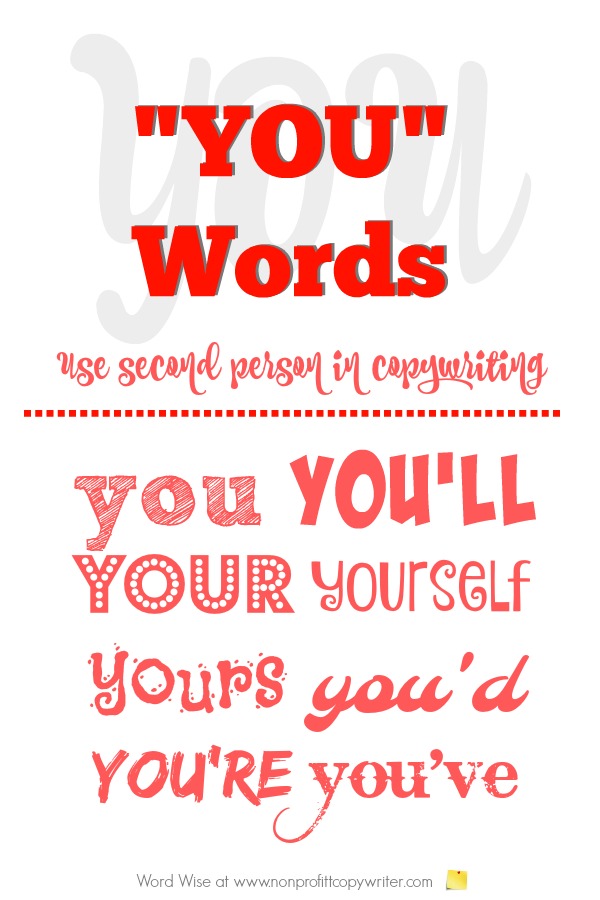Save Time: Get 5 Simple Writing Tips
you can put to use in 10 minutes
Basic Copywriting Rule: How to Make the “You Rule” Work for You
Award-winning writer Kathy Widenhouse has helped hundreds of nonprofits and writers produce successful content , with 750K+ views for her writing tutorials. She is the author of 9 books. See more of Kathy’s content here.
Updated 6.17.25
There's a basic copywriting rule that can change your content almost instantly. And this rule is not just for writing copy that sells. I use it in all kinds of content writing.
The rule is this: focus on your reader by directly addressing them using "you," "your," and "yours." When you use "you" and its relatives freely, your shift focuses from you (and your brand) to the reader. The principle has come to be known in writing circles as “The You Rule.”
How this copywriting rule works
To understand The You Rule, think back to your freshman English teacher. She familiarized you with the concept of “point of view” (POV). She explained that a story is told from the perspective of one of the characters.
- In the first person POV, a character explains his thoughts and actions in his own voice (“My hands were shaking as I reached for the phone.”)
- In the second person POV, you address the reader directly (“You could see my hands shaking as I put the receiver to my ear.”)
- In the third person POV, you allow an outsider to tell the story by looking in (“She felt her hands shaking when the phone rang.”)
The You Rule makes abundant use of second person POV. Doing so allows you to speak one-on-one with your reader and create a rapport – much like you’d do in a friendly conversation.
Why The You Rule works in both copywriting and content writing
A large percentage of copywriting promotional material is written in second person, speaking to the reader straightforwardly by using “you.” For example, I can explain The You Rule to copywriters like this: “By addressing you directly I’m able to let you picture yourself writing powerful copy that grabs the reader and hold his attention.”
This copywriting rule – The You Rule – shifts the perspective from the writer (or the brand) to the reader. Doing so making your content more personal. “You” and “me” act like conversation starters.
- You create a personal connection. Talking one-on-one with your reader creates a feeling of intimacy. When you write in second person, you invite the reader to have a discussion with you, giving the reader a feeling of back-and-forth. In other words, this copywriting rule is really just a fancy way of saying, "Write like you talk."
- You engage readers. By addressing readers directly, you invite them to continue reading … to comment … to share your content.
- You write to real people. By using “you” as you write, you’re naturally forced to hold a conversation on paper. You think about the reader's needs, interests, and concerns. Your content reflects what you envision is relevant and valuable to your reader as you conduct that back-and-forth.
- You build empathy and trust. By focusing on the reader, you show them that you understand his situation. Use The You Rule consistently, and over time your reader begins to feel he knows you and like you. Build that relationship for a long enough time, and Richard Reader begins to trust you. In his eyes, you’re a credible source of information. That makes Richard more likely to respond positively to your content.
Where you can use The You Rule
While The You Rule is a staple in copywriting, it can enhance all kinds of content, including:
- Blog
posts: By engaging readers
directly, your blog posts are more appealing and shareable. That increases
traffic and readership.
Example: One tip that makes readers feel more comfortable with your content. - Emails: Personalized emails that address the
reader directly can lead to higher open rates and click-through rates. The
reason is simple. The content feels less like mass marketing and more like a
personal message.
Example: I want to let you know about a special writing tip that can help you engage more readers. - Social
Media: Social media content fosters
a sense of community. When you speak directly to followers, you encourage them
to interact with you and each other.
Example: Have you tried using The You Rule when you write content? Let us know how it works for you. - Instructional
content: Guides, tutorials, and
how-tos that use "you" can be more user-friendly and easier to follow.
Readers have a better experience when content is presented in second person.
Plus, they retain more.
Example: Try this exercise. Replace “me” words with “you” words and rewrite “you-less” passages. You’ll see how your content is more personal.
Here are some tips to make sure the “You Rule” works for you
- Use both you and I.
First and second POV together create conversation. Copy is personal when it’s directed to the reader in second person (you). And the conversational exchange is complete when you write from first person (I). - Use more you than I.
The reader wants to know that you’re dialoging with him. But his main concern is himself. Effective copy keeps the audience front and center. Be careful that as you share news and information about your product or organization, your copy keeps returning to how those facts affect the reader. Remember, this copywriting rule focuses on the audience - the "you." (Check out this helpful "You Test" as a self-check in your content.) - Use variations of you
and I.
Pronouns your, yours, me, my, mine contribute to the dialogue effect and make your copy interesting. - Use he, she, it
and they.
Yes, copy in third person works! Tell a story or sketch an illustration about another individual and then return to your chatty, second-person banter. For instance, “Martha couldn’t believe the difference in her appetite. In two weeks, she lost eleven pounds. The same can happen to you.”
- Use “you” to distinguish your product’s benefits.
Writing in second person - while only mentioning your product’s features and never talking about its advantages – is a pitfall that’s easy to fall into. For example, “Bring your 4-7 year old to our up-to-date facilities at Little Tykes Tennis Academy, where you’ll find award-winning instructors for your child,” addresses the reader in second person, but only provides facts about your service.
Avoid this trap by making sure you address benefits along with your “you rule” writing, like this: “Help your 4-7 year old learn tennis basics and a love for the game at Little Tykes Tennis Academy, where one-on-one and team coaching in our brand-new facility means your child will have fun, improve his skills and be safe.”
Avoid these pitfalls when using The You Rule
The You Rule is not a guarantee that your content will be effective. Some writers use it as a crutch, rather than a tool, because they’re unaware of a few important principles.
- Overuse. While using "you" is powerful, overdoing it can make your writing sound repetitive or forced. Balance it with other sentence structures to maintain a natural flow.
- Vagueness. Avoid making “you” statements that are too broad or generic. Specificity is key to making the reader feel truly understood. Instead of "You need a solution to help you write better," say, "You need a solution that to help you write more conversationally." Both sentences use “you” and address writers. The first throws a net that is too wide. The second zeroes in on a specific problem.
- Context. In highly formal or technical writing – such as an academic paper or legal document – excessive use of "you" is not fitting.
- Assumptions: When using “you,” be sure the statement applies to anyone who may read it. In other words, don't assume too much about the reader's situation. If you write, “You’ll love using this simple copywriting rule,” you assume that your reader adores acquiring new nitty-gritty writing tricks. Better: “Your writing is more readable when you use this simple copywriting rule.”
Use The You Rule the right way, your reader feels like he knows you. Your content becomes a conversation that helps him understand your point or product or service. And over the course of that conversation, your reader will come to understand what he stands to gain by connecting with you and your content.
More Writing Tips for New Writers
Use the "You Test" for More Persuasive Writing ...
Who Is the Target Audience for Your Content? Here's how to find out ...
What Is Content Writing? Eliminate Confusion With These FAQs ...
Basic copywriting: what is it and why do you need it?
Copywriting - what is copywriting?
Point of view (POV) explained for copywriters and content writers ...
Pre-writing: 4 easy steps to make your writing go faster ...
Basic copywriting: is it a feature or benefit?
Basic copywriting: know your audience before you write ...
4 easy copywriting tricks anyone can master ...
Readability check: an easy way to make your writing cleaner ...
The Power of "Because": persuade by explaining why ...
The simplest, best copywriting tip ...
More Basic Copywriting Tips on our Pinterest board ...
Return from Basic Copywriting Rule: Make the "You Rule" Work for You to Nonprofit Copywriter home
As an Amazon Associate I earn from qualifying purchases.
Share This Page

Named to 2022 Writer's Digest list
BEST GENRE/NICHE WRITING WEBSITE


Stop Wasting Time!
Grab your exclusive FREE guide, "5 Simple Writing Tips You Can Put to Use in 10 Minutes or Less"



BASIC COPYWRITING
Learn from the masters in the acclaimed course, Six-Figure Copywriting. If you can write a simple letter to a friend, you can write promotions that pull and make a living working for yourself as a copywriter. Learn more.











